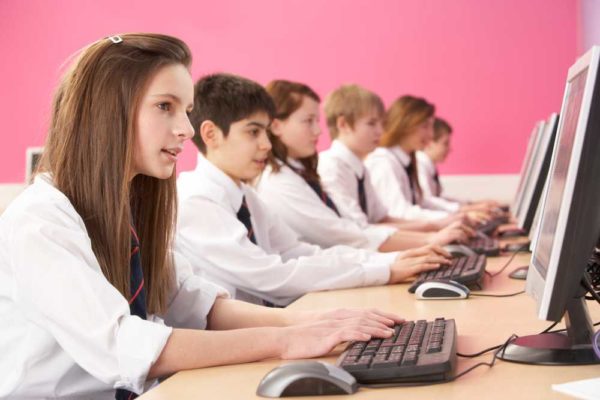The answer is complex — but here’s what the media and some schools get wrong
 During the past few years, I have closely followed the education studies published by the Organisation for Economic Cooperation and Development (OECD). Overall, I find great significance in their findings. However, I was discouraged when I saw recent news articles coming out of the OECD’s latest report on the use of computers in school. Headlines ranged from “Schools wasting money on computers for kids” to “Computers in schools don’t help kids learn.” After taking a close read of the report, I soon realized that these news articles missed the real message.
During the past few years, I have closely followed the education studies published by the Organisation for Economic Cooperation and Development (OECD). Overall, I find great significance in their findings. However, I was discouraged when I saw recent news articles coming out of the OECD’s latest report on the use of computers in school. Headlines ranged from “Schools wasting money on computers for kids” to “Computers in schools don’t help kids learn.” After taking a close read of the report, I soon realized that these news articles missed the real message.
It is true that the OECD report shines a light on some of the limitations of technology use in education. For example, they note that, “technology is of little help in bridging the skills divide between advantaged and disadvantaged students.”
Taken alone, this statement might have led me to question whether the recent rise of technology integration in schools across the country is a smart idea. After all, like many educators, I have more than a passing interest in the subject. My school district has invested in Chromebooks, iPads, and a variety of teaching and learning software computers/devices/programs for students over the past three years leading up to our transformation to one-to-one.
But what the media glossed over is that the OECD report does not in fact recommend that schools start dumping their computers off at their local electronics recycling facility. It only suggests that more research is needed to fully understand next steps for educators, administrators, and policymakers. Importantly, the report suggests that the findings be cautiously interpreted, as developing students’ 21st century skills is more critical than ever, and we don’t want to stifle that effort. This is a far cry from saying that schools are wasting money on technology.
Next page: What makes the difference between tech success and failure
I strongly agree with the OECD’s recommendation that students must develop the 21st century skills necessary to effectively communicate, collaborate, think, and create as global citizens. As educators, this is what we are preparing our students to do. Technology supports students in reaching these goals, but tech alone has never been enough and it never will be. Students cannot achieve these goals without the support of a skilled teacher.
Research has consistently shown that teachers are the most important factor in how much a student will learn. The OECD report recognizes this with respect to education technology: “Technology can amplify great teaching, but great technology cannot replace poor teaching.” As such, it is imperative that we provide teachers with ongoing and relevant professional development to improve and refine their skills.
As in any profession, the expectations and use of new technology should be strategically delivered and not assumed. Professional development should continuously build teacher capacity in research-based teaching strategies and in their content. In particular, schools that are increasing access to technology should offer differentiated professional development that empowers teachers to integrate technology into pedagogy and build their capacity.
For the past four years, my district has been providing teachers with the requisite professional development for the successful integration of technology into pedagogy and content built on Harris, Mishra, and Koehler’s TPACK framework. The TPACK Framework provides a strong foundation for creating a clear understanding of the role of technology in teaching and learning. They advise beginning with lessons familiar to the teacher, and upgrading those activities using technology. I couldn’t agree more—this is a great, proven approach to successfully integrating technology.
Technology integration that is student-centered and evidenced based takes planning, training, collaboration, and time. We began slowly, offering afterschool drop-in sessions in the first year. In the second year, we began more formal learning opportunities including lunch and learns and in-service professional development. In year three, we provided teachers with their own laptops and built professional development sessions modeled after un-conferences, like Edcamps, where teachers engaged in peer-to-peer learning and sharing.
Importantly, we took time to work together before introducing these new models to students. Only now, after three-plus years of PD and training have we provided our students with Chromebooks. Today, we are continuing with our un-conferences, and are adding on additional opportunities for peer-to-peer learning and sharing. We are layering the integration of technology with a commitment to Deeper Learning, using Martinez and McGrath’s Deeper Learning Planning Guide as our frame.
I have been an educator for 22 years and currently serve as assistant superintendent for curriculum and instruction in my Rhode Island district. I have worked as a classroom teacher, as well as an administrator with expertise in technology integration. I have seen the amazing influence that research-based professional development (like the TPACK framework and Deeper Learning) can have in a school or district, to help teachers make the most of new investments, including curriculum, technology, or other instructional resources.
In my district, our teachers have been able to use technology to support problem-based learning, virtual fieldtrips, formative assessments (which help teachers understand what students know and what they’re struggling with in almost real-time), flipped classroom models, research, and intervention. Because of tech, teachers are transforming the teaching and learning experiences for their students, while increasing both relevance and rigor.
Technology can be exciting, and with that excitement, it is easy for me to understand why there is a misconception that technology alone has the capacity to improve educational outcomes. We must remember that technology is only a tool, and we cannot expect a tool to provide the panacea for all that is not working in education. Like anything else, overuse or over-reliance on technology will not lead to positive student outcomes. However, a failure to integrate technology into deeper learning will certainly place our students at a global disadvantage. As the OECD stresses in this latest report:
“Empowering young people to become full participants in today’s digital public space, equipping them with the codes and tools of their technology-rich world, and encouraging them to use online learning resources—all while exploring the use of digital technologies to enhance existing education processes…are goals that justify the introduction of technology into the classroom.”
With support, technology can assist teachers in transporting students to places previously unimaginable, challenging students with problems previously too complex, and sharing student successes with wider audiences than previously possible.
Paula Dillon is the assistant superintendent for curriculum and instruction in Barrington, R.I., and contributor to the Smarter Schools Project, a national forum highlighting the use of technology in schools.
- TC- What student choice and agency actually looks like - November 15, 2016
- What student choice and agency actually looks like - November 14, 2016
- App of the Week: Science sensor meets your smartphone - November 14, 2016

